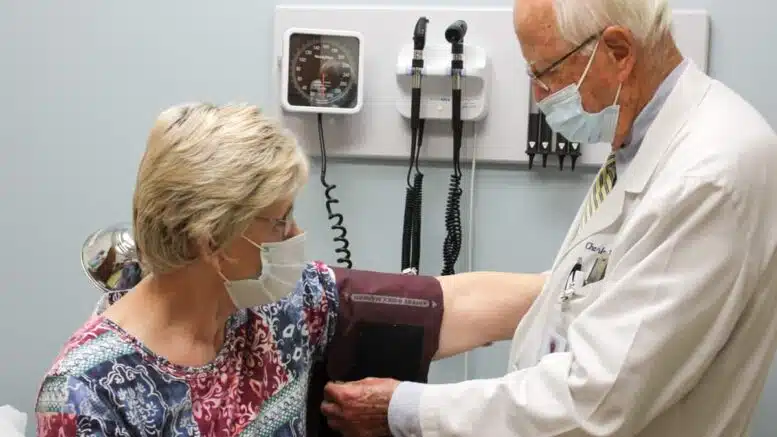By Liz Carey
A new study from the American Academy of Family Physicians’ Robert Graham Center (AAFP), co-funded by the Milbank Memorial Fund and The Physicians Foundation, has found that communities across the country are struggling to meet the demand for primary care physicians, as well as to retain those physicians in their communities. While it’s difficult all over, Dr. Yalda Jabbarpour, lead researcher on the study, said, it is more difficult for rural communities.
“Ten years ago, we knew we had a problem with primary care physician density,” Jabbarpour said in an interview with the Daily Yonder. “Today, even though people are older, and therefore sicker, and the population is growing and the demands are higher, we actually have less physicians to fill that need.”
Rural communities tend to depend more on primary care clinicians, Jabbarpour said, especially family physicians.
In 2021, 37% of all physicians in training (residents) began training in primary care, yet only 15% of all physicians were practicing primary care three to five years after residency, the study found.
More than half of those residents with the potential to enter primary care subspecialized or became hospitalists instead, research showed. And only 15% primary care residents spent a majority of their time training in outpatient settings where a majority of the US population receives their care and fewer than 5% of primary care residents spent time training in rural and other underserved communities, the researchers found.
The AAFP study also found that there is a slightly higher density of primary care providers in rural and underserved areas. Looking at social drivers of health – like housing, transportation, income and education – and how they affect residents’ health status, the study found that people in areas that have more social disadvantages (less adequate housing, barriers to transportation, and lower income, for instance) had higher rates of chronic disease and worse health outcomes.
In 2021, the overall density of primary care in areas that had more social disadvantages was 111.7 per 100,000, while the density of areas with fewer social disadvantages was 99.5 per 100,000. However, researchers said, while those measures are hopeful, they still are insufficient.
“This finding may be attributed, in part, to the success of the community health center movement, which aims to place clinicians in areas of highest social need,” researchers said. “Still, this promising finding needs to be tempered by the reality that even this higher density of primary care clinicians may not meet patient demands given that people living in high-need areas tend to have higher levels of medical need.”
“Rural areas do much better at training and retaining a primary care workforce, but at the same time, it’s still not enough to meet the growing demand,” Jabbarpour said.
Family medicine, like any other medical specialty, she said, distributes itself the same as the U.S. population. Rural areas across the country, according to the U.S. Census Bureau, are home to 19.88% of the total U.S. population. Jabbarpour said that a correlating percentage of primary care physicians would be located in a rural area. But because rural communities tend to be statistically older and sicker, the need in rural communities is greater.
One way to resolve the issue would be for more investment into primary care, the study found. Changing the overall portion of health care spending done by the Centers for Medicare and Medicaid (CMS) on primary care would help invest more federal dollars into primary care, as would investment by the U.S. Department of Health and Human Services (HHS) into new rural health clinics, health centers and Indian Health Service (IHS) facilities in shortage areas, the report said.
“The United States is underinvesting in primary care, and Medicare’s fee schedule – which lists fees for services – is the chief culprit,” the report said. “It undervalues primary care services relative to specialty services and pays on a per visit basis, discouraging non-visit services like emails and phone calls as well as care from other members of the primary care team.”
Jabbarpour said another key to getting more primary care physicians into rural communities is for colleges to recruit from rural communities.
“Medical schools should be recruiting from those communities because people tend to go home to practice,” she said.
Bringing doctors into rural areas means helping their spouses find work as well.
“There are physicians who want to go into rural areas, but their partners don’t have opportunities for work in rural areas if they’re not also in medicine,” she said.
The biggest way to bring primary care physicians into rural areas, she said, was to expose them to it. The research has found that physicians who train in Teaching Health Centers and rural training tracks are more likely to practice in those communities.
“I know not every rural area is the same. In some rural areas, it’s probably an area that physicians would love to live and grow their families in if they knew about it,” she said. “I know that’s hard because that takes hospital systems really doing active recruitment or setting up rural training tracks, and reaching out to medical schools around the country and saying, hey, send your students here, we’ll give them housing and they can get exposure to this beautiful slice of heaven that we have and then they’ll want to come here.”








